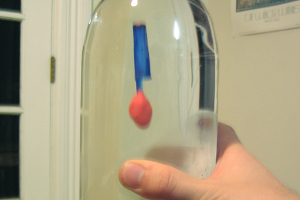 The Cartesian Diver: this is a classic demo named after the17th-century philosopher and mathematician René Descartes.
The Cartesian Diver: this is a classic demo named after the17th-century philosopher and mathematician René Descartes.
Buoyancy is the force that decides whether an object will sink or float, and has had a long and colorful history. As the story goes, the Greek thinker Archimedes was sitting in his bathtub one day when he noticed how the water around him rose when he got in. Suddenly, he realized that he could use the water level rise to measure an object’s volume. Shouting “Eureka!” he burst out of the tub and ran out into the streets stark naked.
Fascination with buoyancy continues into modern times. Astronauts have exploited buoyancy to simulate being in space. Scuba divers use it to turn the underwater world into their playground. And then of course there is David Letterman’s Will it Float?, an entire sketch dedicated to watching what happens when something is dropped into a giant pool of water. Demonstrations at home of buoyancy are easy to come by, too. Below are two of my favorites.
Cartesian Diver
This is a classic demo named after the17th-century philosopher and mathematician René Descartes, although curiously, no one seems to know why. Build a miniature model of a submarine here and take control of an object’s depth.
